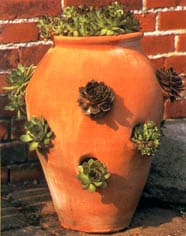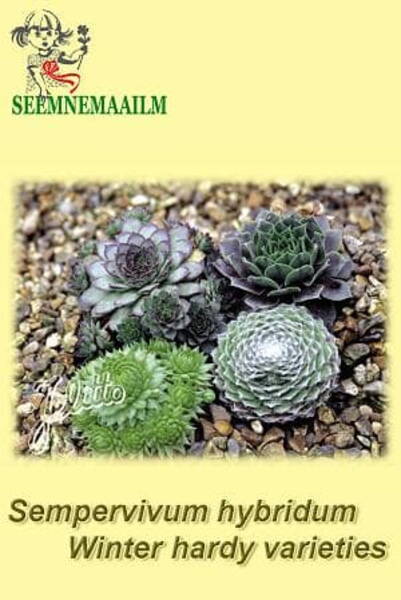Your shopping cart is empty!
Common houseleek "Hippie Chicks" mix
Sempervivum × hybridum hort.
3.03€
Ex Tax: 2.45€
Ex Tax: 2.45€
Common houseleek "Winter hardy Varieties" - Sempervivum hybridum.
Under this name, varieties and forms of complex hybrid origin are combined.
Name: comes from the Latin words "semper" - always and "vivus" - alive, for the ability of leaf rosettes to maintain viability in extreme conditions of existence.
In Russia, the plant is also called "stone rose", "hare like a bush", "rejuvenated". At the time of flowering, the juvenile resembles a hen surrounded by numerous chickens.
Hence its popular English name "Hens and Chickens".
With the invariable perfection of their rosettes, juveniles are infinitely diverse in shape and colour of leaves. The first experiences of using young people in landscape design date back to the Middle Ages.
The inhabitants of medieval Europe completely planted them on the flat roofs of their houses. The memory of this is preserved in the name of one of the species - young roofing (Sempervivum tectorum). This plant was also used as a living tile in England.
Location: all species require well-lit areas, but can tolerate light shade. In the shade, the plants lose their compactness, their leaves become pale green and elongate. Soil: grow well in any cultivated soil, avoiding damp. But dry, poor, sandy soils are preferred. If the soil contains a lot of nutrients, then the plant, although it forms larger rosettes, will be somewhat paler in colour than usual, and they themselves will be less resistant to overwintering. Soils for all species are desirable neutral or slightly alkaline.
Landing: plants are planted so that the distance between specimens of large species is 10-15 cm, small ones - 3-5 cm. In a year, daughter rosettes will completely cover the surface of the soil. Care: consists in the timely removal of weeds and faded inflorescences, along with a dead rosette of leaves. The young are watered only once - after planting. In moist soil, the lower leaves in the rosettes begin to rot. This is the first sign of excess moisture.
Reproduction: usually vegetative, seed propagation is impractical, since most species form a large number of small daughter rosettes. Their separation and planting is usually carried out in the spring, sometimes in the summer. Very small rosettes are grown on ridges, large ones are immediately planted in a permanent place, maintaining a distance of 10 cm. Seeds are sown in February-March to a depth of no more than 1 mm. Germinated at +20°C. Shoots appear in 3-5 days. Seedlings are kept in the light, protected from the hot sun. Planted in a permanent place in late June - July. Young easily tolerates a long journey in postal parcels and does not need special packaging.
Use: very effective in group plantings on the south side of bushes, in carpet compositions, on rocky areas and slopes. The young are very good in groups of different varieties and species against the background of boulders.
Partners: doesn't get along with lush plants! Suitable: Dianthus, Saxifraga, Sedum.
Under this name, varieties and forms of complex hybrid origin are combined.
Name: comes from the Latin words "semper" - always and "vivus" - alive, for the ability of leaf rosettes to maintain viability in extreme conditions of existence.
In Russia, the plant is also called "stone rose", "hare like a bush", "rejuvenated". At the time of flowering, the juvenile resembles a hen surrounded by numerous chickens.
Hence its popular English name "Hens and Chickens".
With the invariable perfection of their rosettes, juveniles are infinitely diverse in shape and colour of leaves. The first experiences of using young people in landscape design date back to the Middle Ages.
The inhabitants of medieval Europe completely planted them on the flat roofs of their houses. The memory of this is preserved in the name of one of the species - young roofing (Sempervivum tectorum). This plant was also used as a living tile in England.
Location: all species require well-lit areas, but can tolerate light shade. In the shade, the plants lose their compactness, their leaves become pale green and elongate. Soil: grow well in any cultivated soil, avoiding damp. But dry, poor, sandy soils are preferred. If the soil contains a lot of nutrients, then the plant, although it forms larger rosettes, will be somewhat paler in colour than usual, and they themselves will be less resistant to overwintering. Soils for all species are desirable neutral or slightly alkaline.
Landing: plants are planted so that the distance between specimens of large species is 10-15 cm, small ones - 3-5 cm. In a year, daughter rosettes will completely cover the surface of the soil. Care: consists in the timely removal of weeds and faded inflorescences, along with a dead rosette of leaves. The young are watered only once - after planting. In moist soil, the lower leaves in the rosettes begin to rot. This is the first sign of excess moisture.
Reproduction: usually vegetative, seed propagation is impractical, since most species form a large number of small daughter rosettes. Their separation and planting is usually carried out in the spring, sometimes in the summer. Very small rosettes are grown on ridges, large ones are immediately planted in a permanent place, maintaining a distance of 10 cm. Seeds are sown in February-March to a depth of no more than 1 mm. Germinated at +20°C. Shoots appear in 3-5 days. Seedlings are kept in the light, protected from the hot sun. Planted in a permanent place in late June - July. Young easily tolerates a long journey in postal parcels and does not need special packaging.
Use: very effective in group plantings on the south side of bushes, in carpet compositions, on rocky areas and slopes. The young are very good in groups of different varieties and species against the background of boulders.
Partners: doesn't get along with lush plants! Suitable: Dianthus, Saxifraga, Sedum.

Eng.: Houseleek, hens and chicks. Bot. syn.: Sempervivum tectorium L.












